| Study Case | https://doi.org/10.21041/ra.v10i3.468 |
Time variability analysis for damage detection in flexible pavement using infrared thermography
Análise do melhor horário para a detecção de danos em pavimentos flexíveis usando termografia infravermelha
Análisis de la variabilidad horaria para la detección de daños en pavimentos flexibles usando termografía infrarroja
M.
Pacara-Copa1
*
![]() , J. H. A.
Rocha2
, J. H. A.
Rocha2
![]() , J. S.
Ledezma-Perez1
, J. S.
Ledezma-Perez1
![]()
1 Departamento de Ingeniería Civil, Facultad de Ciencias y Tecnología, Universidad Mayor de San Simón, Cochabamba, Bolivia.
2 Departamento de Ingeniería Civil, Facultad de Tecnología, Universidad Privada del Valle, Cochabamba, Bolivia.
*Contact author: marinapacara@gmail.com
Reception: March 22, 2020.
Acceptance: August 05, 2020.
Publication: September 01, 2020
| Cite as: Pacara-Copa, M., Rocha, J. H. A., Ledezma-Perez, J. S. (2020), "Time variability analysis for damage detection in flexible pavement using infrared thermography", Revista ALCONPAT, 10 (3), pp. 350 – 293, DOI: https://doi.org/10.21041/ra.v10i3.468 |
Abstract
This document discusses the time range to optimize and understand infrared thermography results when used on damage detection for flexible pavement. A monitoring activity was performed during 14 continuous hours (5:00 a.m. to 7:00 p.m.) for four study areas in a centrally located avenue in Cochabamba City, Bolivia. This activity evidenced an effective time range to take thermographic images from 11:00 a.m. to 4:00 p.m. Damage visualization by differential colorimetry in thermograms at different times was also verified. This test enables locating areas where a detailed inspection may be performed. As a limitation, its sensibility to changes under environmental conditions is evident.
Keywords:
infrared thermography,
flexible pavement,
inspection.
Resumo
En este trabajo se discute el rango horario para optimizar e interpretar los resultados de la termografía infrarroja cuando es utilizada en la detección de daños de pavimentos flexibles. Se realizó un seguimiento de 14 horas continuas (5:00 a.m. a 7:00 p.m.) para cuatro zonas de estudio en una avenida céntrica de la ciudad de Cochabamba, Bolivia. El seguimiento evidenció un rango horario óptimo para la toma de imágenes termográficas de 11:00 a.m. hasta las 4:00 p.m.; también se constató la visualización del deterioro mediante la colorimetría diferenciada en los termogramas a diferentes horas. Este ensayo permite localizar las áreas en las que se puede efectuar una inspección detallada. Como limitante se tiene su sensibilidad a cambios en las condiciones ambientales.
Palavras-chave:
termografía infravermelha,
pavimento flexível,
inspeção.
Resumen
En este trabajo se discute el rango horario para optimizar e interpretar los resultados de la termografía infrarroja cuando es utilizada en la detección de daños de pavimentos flexibles. Se realizó un seguimiento de 14 horas continuas (5:00 a.m. a 7:00 p.m.) para cuatro zonas de estudio en una avenida céntrica de la ciudad de Cochabamba, Bolivia. El seguimiento evidenció un rango horario óptimo para la toma de imágenes termográficas de 11:00 a.m. hasta las 4:00 p.m.; también se constató la visualización del deterioro mediante la colorimetría diferenciada en los termogramas a diferentes horas. Este ensayo permite localizar las áreas en las que se puede efectuar una inspección detallada. Como limitante se tiene su sensibilidad a cambios en las condiciones ambientales.
Palabras clave:
termografía infrarroja,
pavimento flexible,
inspección.
1. Introduction
Road infrastructure works are very important for socioeconomic development in any country, since they allow for mobilization of people and goods (Vyas et al., 2019). However, these works suffer damages (fissures, deformation, delamination, etc.); therefore inspection, maintenance and reconditioning activities are required in order to guarantee their useful life and provide optimal service conditions (Solla et al., 2014).
In Bolivia, road maintenance and conservation started when the Bolivian-American Cooperation Road Service (Servicio Cooperativo Boliviano Americano de Caminos-SCBAC) was founded in 1955 (Lovera, 2017). Later, in 1961, National Road Service Agency (Servicio Nacional de Caminos - SNC) was created. This entity was in charge of managing and maintaining roads all over the country. In 2006 it was replaced by Bolivian Road Administration Agency (Administradora Boliviana de Carreteras - ABC) according to Law 3507 (Bolivia, 2006a), whose institutional mission is to integrate the country by planning and managing the Main Road Network (Red Vial Fundamental - RVF) (Bolivia, 2006b). ABC activities include: planning, management, study and engineering, construction, maintenance, preservation and operation for RVF and its access roads (ABC, 2011).
Despite standards and institutions in charge of road conservation, a great percentage of roads show visible issues in Bolivia, mainly on flexible pavement (Los Tiempos, 2016, 2019; Opinión, 2018). Timely care for road maintenance and/or rehabilitation exceeds capacity of pertinent entities such as ABC. This situation is caused by lack of inspection techniques. Many main roads, mostly in cities, are not properly inspected to minimize of traffic interruption. This aspect avoids appropriate evaluation and diagnosis of current conditions on flexible pavement. Therefore, actions taken for rehabilitation are incorrect or improvised in many cases.
Some methods for infrastructure inspection in both concrete or flexible pavement bridges and roads are bibliographically available (Rehman et al., 2016; Janků et al., 2019; Dong et al., 2016). The most widely used method is the ground-penetrating radar (georadar) (Khamzin et al., 2017; Fernandes & Pais, 2017; Tosti et al., 2018). Nevertheless, a direct contact with infrastructure and interrupting vehicle traffic are required. Hence, techniques for an inspection without traffic interruption and remotely efficient are required. Accordingly, infrared thermography rises as an alternative for this purpose. This technique does not required direct contact with the inspected subject and may be performed at different distance rates. (Baggathiappan et al., 2013; Rocha et al., 2017).
Although inspection studies for pavement using infrared thermography are available (Garrido et al., 2018; Golrokh and Lu, 2019), bibliography related to flexible pavement is scarce (Solla et al., 2014; Lin et al., 2018; Vyas et al., 2019). Therefore, evaluating capacities and limitations -as an inspection method for flexible pavement mostly in situ is still required, since reported information is experimental and has been applied in different places.
In this sense, this document is intended to discuss a time range to optimize and understand infrared thermography results when used for damage detection on flexible pavement, considering two sections of San Martin Avenue in Cochabamba City, Bolivia as a study case. This selected section is characterized by showing high vehicle traffic and jam as well as damaged flexible pavement (Los Tiempos, 2016).
2. Infrared thermography
Thermal radiation is the type of electromagnetic radiation that comprises heat transference and it is emitted as a consequence of energy transition in molecules, atoms and electrons. The intensity of infrared radiation emitted by a body depends on the temperature of its surface. Thereby, it is considered that any body whose temperature is above absolute zero (0 K) emits infrared radiation (Rocha et al., 2017).
Thermal energy irradiated by an object is expressed according to the energy emitted by a perfect radiator called a black body or ideal emitter (Cengel, 2003).
The human eye may see radiation in the electromagnetic spectrum between 0.4 - 0.7 μm (visible spectrum), the infrared band ranges 0.9 - 14 μm, equipment being necessary for its detection. Thermographic cameras, used for inspection, work in this infrared band. The ratio between electromagnetic radiation and temperature is explained through Stephan-Boltzman Law equation (1) (Baggathiappan et al., 2013).
 |
(1) |
Where W is radiation intensity (w/m²), σ is Stephan - Boltzmann Constant (5.67*10-8 W/m²*K4), ɛ is surface emissivity, and T is temperature measured (K).
3. Procedure
In order to meet the objective intended in this article, a monitoring activity during 14 continuous hours was performed on July 20 to 27, 2020. Thermographic images were taken every hour, considering midday as a time axis, meaning 7 hours before and 7 hours after were considered. Monitoring time range was from 5:00 a.m. to 7:00 p.m.
Two sections were considered as case study: the first was located on San Martin Avenue between Jordan and Sucre Streets, where Palace of Justice is across from 25 de Mayo Market, and the second was on San Martin Avenue between Heroinas Avenue and Colombia Street where many stores and optical shops are located.
Each study section was divided in two areas to take thermograms. Figure 1 shows the areas where thermografic images were taken. Area 1 is located on the corner of San Martin Avenue and Jordan Street on the southeastern sidewalk, where panoramic images of the whole sidewalk were taken. Area 2 is located in the middle of Section 1: San Martin Avenue between Jordan and Sucre Streets on the eastern sidewalk. Area 3 is located in the intersection of San Martin Avenue and Heroinas Avenue on the central green space. Area 4 is located in the middle of Section 2 on San Martin Avenue between Heroinas Avenue and Colombia Street.
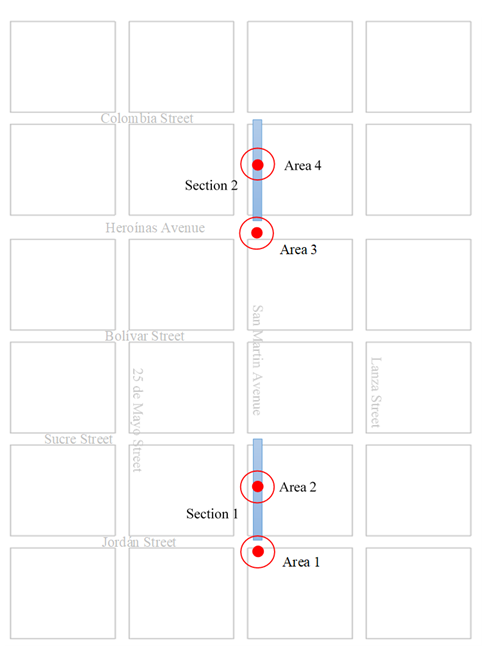 |
||||
| Figure 1. Areas to take thermografic images. | ||||
The equipment used was a CAT S60 equipped including an FLIR integrated camera, whose characteristics are detailed in Table 1.
| Table 1. S60 MyFLIR specifications. | ||||||||||||||
| Thermal and visual camera including MSX | ||||||||||||||
|---|---|---|---|---|---|---|---|---|---|---|---|---|---|---|
| Thermal Sensor | Pixel size: 17 mm. Spectral range: 8 to 14 mm. | |||||||||||||
| Thermal Resolution | 80 x 60 | |||||||||||||
| Visual Resolution | 640 x 480 | |||||||||||||
| HFOV/VFOV | 46º ± 1º/35º±1º | |||||||||||||
| Image Frequency | 8,7 Hz | |||||||||||||
| Focus | Fixed 15 cm – Infinite | |||||||||||||
| Integrated in Shutter | Automatic/manual | |||||||||||||
| Radiometry | ||||||||||||||
| Dynamic scene range | -20ºC - 120ºC | |||||||||||||
| Precision | ±5ºC o ±5% | |||||||||||||
| Difference percentage between ambient temperature and scene | ||||||||||||||
| 60 s applicable after start when unit is located between 15ºC and 35ºC, and the scene is located between 10ºC and 120ºC. | ||||||||||||||
| Thermal Sensitivity (MRDT) | 150 mK | |||||||||||||
| Source: FLIR (2016) | ||||||||||||||
Thermograms resulting from monitoring (including a 1-hour interval) were processed and analyzed by FLIRTools program.
Besides being a tool that facilitates inspection reports, FLIRTools edits and analyzes images quickly, for this program has an option to adjust and modify parameters and enables scaling temperature ranges and/or change colorimetry according to any scenario relevant to the study.
4. Results
Results submitted are dated July 22, 2018, because it enabled detection of thermal gradients and data repeatability. It is worth mentioning that due to technique sensitivity to environmental conditions (intermittent cloudiness and rain) many days were interrupted or excluded for this activity.
Thermograms for all four areas were analyzed in a visual manner, in the first intances, and then in a quantitative manner,in order to determine the optimal range for data collection to detect damage in flexible pavement. At the same time, qualities of FLIRTools were analyzed for the benefit of proposed technique.
4.1 Visibility of damage on paving surface in thermographic images
After in situ monitoring, damage visibility in thermografic images was verified. Figure 2 shows Area 4, and Figure 3 shows the corresponding thermogram.
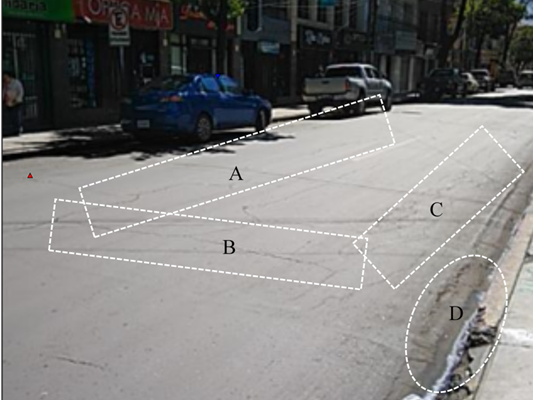 |
||||
| Figure 2. Digital image for Area 4. | ||||
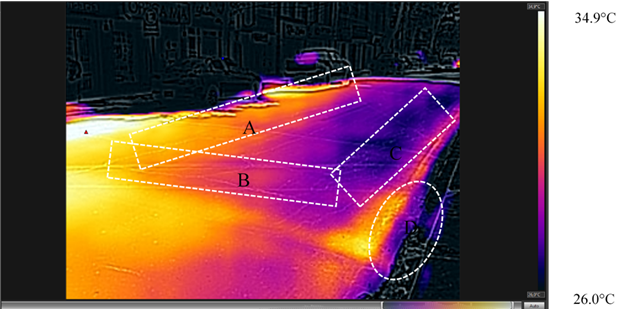 |
||||
| Figure 3. Thermal image for Area 4. | ||||
Figure 2 shows transversal (B) and longitudinal (A) cracking, crocodile leather texture (C), and aggregate detachment (D) among other defect appearances. Figure 3 shows the thermographic image of previously mentioned area, where varied colorimetry can be seen. This evidences a previous relation to damages observed in Figure 2.
It can be noticed that the thermographic image in Figure 3 shows the temperature ranges on the right side; this range varies from 26°C to 34.9°C. Yellow with white tendency areas represent high temperatures and blue with black tendency areas represent low temperatures. This color pallet may be modified at user convenience. However, no uniformity in asphaltic pavement is observed, since cold and hot areas are distinguished.
4.2 Variation in thermographic images at different times
Differential colorimetry in Area 1 at different times of the day was visually analyzed under the same temperature range with FLIRTools program. Figure 4 shows thermographic images in Area 1 during three different times and under the same temperature range. This temperature was 23°C as the maximum and 16°C as the minimum range. Figures 4a, 4b y 4c represent 7:00 a.m., 1:00 p.m. and 6:00 p.m., respectively.
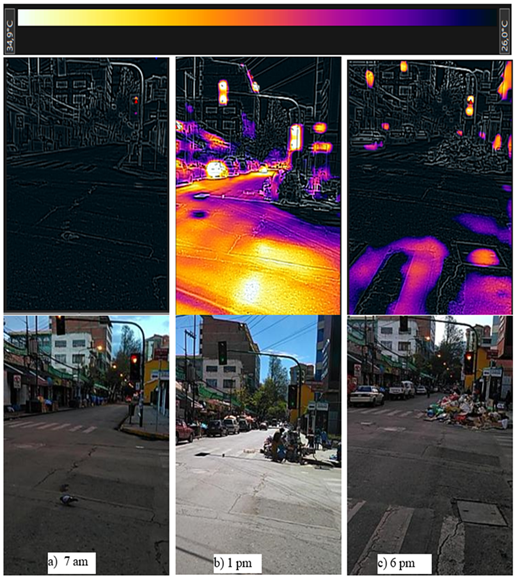 |
||||
| Figure 4. Visibility of thermografic images at different day times in Area 1. | ||||
When observing thermographic images related to digital images, it can be noticed that Figure 4b, representing 1:00 p.m., shows flexible asphalt showing different temperatures on its surface, unlike Figure 4a (7:00 a.m.) that shows no difference in pavement temperatures. Figure 4c (6:00 p.m.) shows that only some areas in pavement reveal temperatures close to maximum value, according to temperature range established.
4.3 Determining optimal time range during daytime to take thermographic images
In order to determine optimal time range to take thermographic images, temperature difference in two sections with different characteristics was used in order to obtain a differential that might be evaluated by a graphics.
In order to obtain the difference in temperatures, the equation (2) was used, which is an expression proposed in bibliography for a qualitative and quantitative analysis of results (Washer et al., 2010; Farrag et al., 2016; Rocha et al., 2017).
 |
(2) |
Where ΔT is the differential or thermal gradient (°C), Tc is the temperature of damaged area in the study (°C), and Tf is the temperature of an area other than the damaged one (°C).
Figures 5, 6, 7 and 8, show temperature variation during monitoring period for two points with different characteristics. Each figure shows results for each of all four analyzed areas, this is to distinguish the thermal differential or temperature gradient (ΔT).
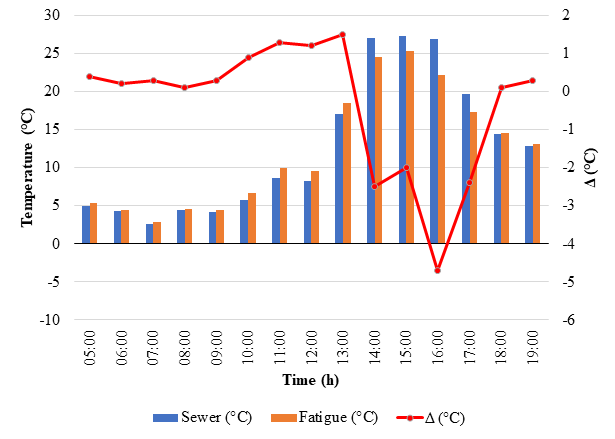 |
||||
| Figure 5. Temperatures in Area 1. | ||||
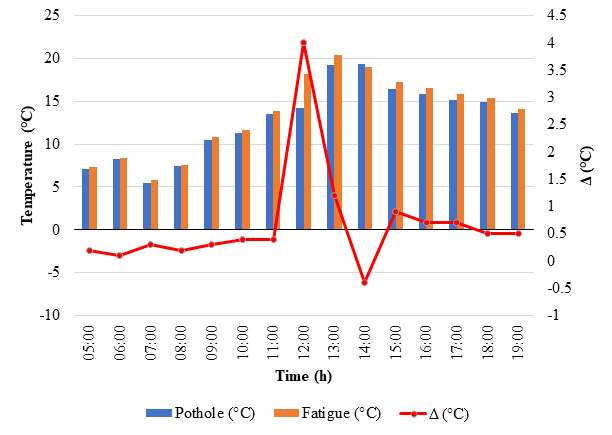 |
||||
| Figure 6. Temperatures in Area 2. | ||||
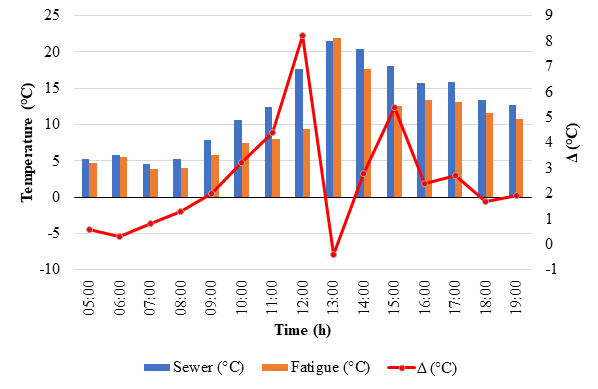 |
||||
| Figure 7. Temperatures in Area 3. | ||||
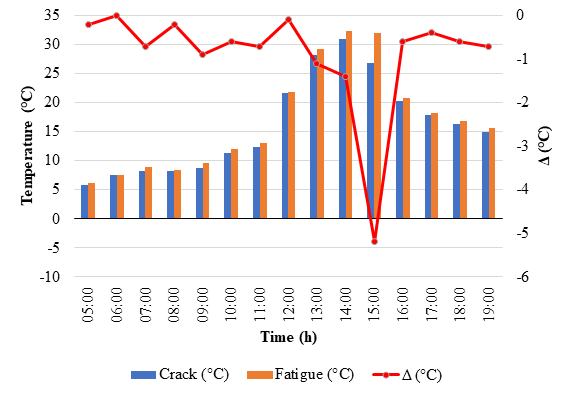 |
||||
| Figure 8. Temperatures in Area 4. | ||||
Figure 9 shows temperature differential (ΔT) for all four areas regarding time as well as ambient temperature and relative humidity. Maximum values for thermal gradients given between 11:00 a.m. and 4:00 p.m. are shown. It can also be seen that between 5:00 a.m. and 8:00 a.m., differential values are minimal, being this an ineligible period for an appropriate analysis. The period from 4:00 p.m. to 7:00 p.m. shows small differential values, due to cooling process (evening). Once solar radiation is absent, heated sections tend to balance with the environment (Washer et al., 2010), Figure 4c. It can be observed that the best period is between 11:00 a.m. and 4:00 p.m. because a greater differential in temperature is present, which enables visualization of defect appearances in thermograms. This is consistent with other investigations indicating that whenever thermal gradients are higher, defect appearances are detected (Solla et al., 2014; Farrag et al., 2016; Rocha et al., 2017).
Regarding thermal gradient behavior with ambient temperature and relative humidity, it can be observed that maximum gradients occur when ambient temperature is high and relative humidity is low. Otherwise, when ambient temperature is low relative humidity is high, lower thermal gradients are present, 5:00 a.m. to 8:00 a.m., which confirm this technique is sensitive to environmental conditions (Rocha & Póvoas, 2017).
Even though this article was only applied in a single period of the year, this technique may be used in any season. Solar exposure and a high ambient temperature are required. Nevertheless, optimal periods for inspection will change according to the season, depending on times of exposure to solar radiation and ambient temperature (Washer et al., 2010).
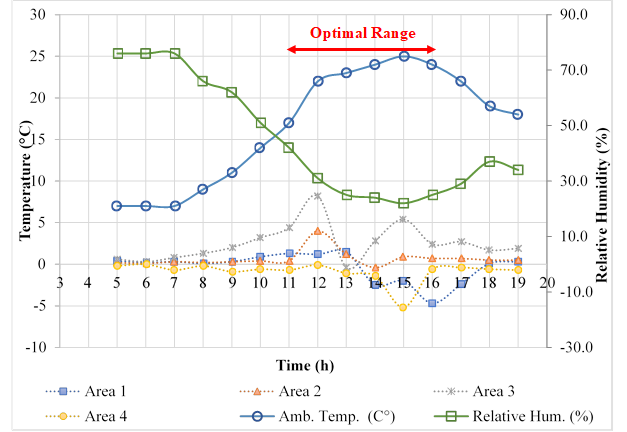 |
||||
| Figure 9. Temperature gradient in all four study areas. | ||||
5. Conclusions
Implementing infrared thermography to detect damage in flexible pavement generate positive results. This test may be considered as a preliminary non-destructive inspection method since it can analyze large areas in small intervals of time. However, these periods are limited during afternoon hours. The optimal range found for inspection was from 11:00 a.m. to 16:00 p.m.
This technique may detect invisible anomalies, showing an impacted section, but not the type or extent of damage. This aspect requires a detailed inspection where other studies and tests may accurately determine the type and nature of damage reflected by colorimetry in a thermogram.
This technique shows low thermal gradients on cloudy days as opposed to sunny days including high temperatures. Sudden temperature changes during monitoring activities reveal discontinuous data that are detrimental to analysis of damage behavior in flexible pavement, most of all regarding preliminary inspections. Implementing active infrared thermography and other non-destructive tests may reduce these uncertainties and generate more objective results.
References
ABC - Administradora Boliviana de Carreteras (2011), “Manual de diseño de conservación vial”. ABC, La Paz, Bolivia, p. 365. Last access on May 30, 2019. Available at: http://www.abc.gob.bo/wp-content/uploads/2018/09/manual_de_diseno_de_conservacion_vial_abc.pdf
Bagavathiappan, S., Lahiri, B., Saravanan, T., Philip, J. (2013), Infrared thermography for condition monitoring - A review. Infrared Physics & Technology. 60(1):35-55. Doi: https://doi.org/10.1016/j.infrared.2013.03.006
Bolivia (2006a), Ley N°3507, 27 de octubre de 2006. Último acceso 30 de mayo de 2019. Disponible en: http://www.abc.gob.bo/wp-content/uploads/2018/07/Ley_3507.pdf
Bolivia (2006b), Decreto Supremo N°28946, 25 de noviembre de 2006. Last access on May 30, 2019. Available at: http://www.abc.gob.bo/wp-content/uploads/2018/07/Decreto_Supremo_N%C2%BA_28946.pdf
Cengel, Y. (2003), “Heat Transfer, a practical approach”. McGraw-Hill, Segunda Edición, p. 932.
Farrag, S., Yehia, S., Qaddoumi, N. (2016). Investigation of Mix-Variation Effect on Defect- Detection Ability Using Infrared Thermography as a Nondestructive Evaluation Technique. Journal of Bridge Engineering, 21(3):1-15. Doi: https://doi.org/10.1061/(ASCE)BE.1943-5592.0000779
Fernandes, F. M., Pais, J. C. (2017), Laboratory observation of cracks in road pavements with GPR. Construction and Building Materials, 154:1130-1138. Doi: https://doi.org/10.1016/j.conbuildmat.2017.08.022
FLIR (2016), “Smartphone S60 de Cat® Manual del usuario”. Last access on May 28, 2019. Available at: https://www.catphones.com/download/User-Manuals/S60-Smartphone/S60-Manual-del-usario-Espa%C3%B1ol.pdf
Garrido, I., Lagüela, S., Arias, P. (2018), Infrared Thermography’s Application to Infrastructure Inspections. Infrastructures, 3(3):1-19. Doi: https://doi.org/10.3390/infrastructures3030035
Golrokh, A. J., Lu, Y. (2019), An experimental study of the effects of climate conditions on thermography and pavement assessment. International Journal of Pavement Engineering, 1-12. Doi: https://doi.org/10.1080/10298436.2019.1656809
Janků, M., Cikrle, P., Grošek, J., Anton, O., Stryk, J. (2019), Comparison of infrared thermography, ground-penetrating radar and ultrasonic pulse echo for detecting delaminations in concrete bridges. Construction and Building Materials, 225:1098-1111. Doi: https://doi.org/10.1016/j.conbuildmat.2019.07.320
Khamzin, A. K., Varnavina, A. V., Torgashov, E. V., Anderson, N. L., Sneed, L. H. (2017), Utilization of air-launched ground penetrating radar (GPR) for pavement condition assessment. Construction and Building Materials, 141:130-139. Doi: https://doi.org/10.1016/j.conbuildmat.2017.02.105
Lin, S., Ashlock, J., Williams, R. C., Lee, H. D., Wang, Y. (2018), Evaluation of three nondestructive testing techniques for quality assessment of asphalt pavements. Nondestructive Testing and Evaluation, 33(4):361-375. Doi: https://doi.org/10.1080/10589759.2018.1484921
Los Tiempos (2016), “Caos de tráfico vehicular en la ciudad de Cochabamba”. Last access on May 30, 2019. Available at: http://www.lostiempos.com/actualidad/opinion/20161221/columna/caos-trafico-vehicular-ciudad-cochabamba
Los Tiempos (2016), “Población protesta por el mal estado de las calles en Cochabamba”. Last access on June 25, 2019. Available at: https://www.lostiempos.com/actualidad/local/20160420/poblacion-protesta-mal-estado-calles-cochabamba
Los Tiempos (2019), “Cochabamba: ciudad de baches y eternas fallas en el asfalto”. Último acceso 25 de junio de 2020. Disponible en: https://www.lostiempos.com/especial-multimedia/20190408/cochabamba-ciudad-baches-eternas-fallas-asfalto
Lovera, G. C. (2017), “La política caminera del modelo de capitalismo de Estado de 1952 - 1985”, Tesis de licenciatura, Universidad Mayor de San Andrés, p. 126.
Muñoz-Potosi, A., Pencue-Fierro, L., León-Téllez, J. (2009), Análisis Termográfico Para La Determinación De Puntos Críticos En Equipos Mecánicos Y Eléctricos. Bistua: Revista de la Facultad de Ciencias Básicas, 7(1):1-4. Available at: http://www.redalyc.org/articulo.oa?id=90312171013
Opinión (2018), Alcaldía inicia reparación de baches en las calles. Último acceso 25 de junio de 2020. Disponible en: https://www.opinion.com.bo/articulo/cochabamba/alcald-iacute-inicia-reparaci-oacute-n-baches-calles/20180220000500605048.html
Rehman, S., Ibrahim, Z., Memon, S. A., Jameel, M. (2016), Nondestructive test methods for concrete bridges: A review. Construction and Building Materials. 107(15):58-86. Doi: https://doi.org/10.1016/j.conbuildmat.2015.12.011
Revillas, S. (2011), “Guía de la termografía infrarroja, aplicaciones en ahorro y eficiencia energética”. eBuilding, Madrid, España, p. 189. Available at: https://www.fenercom.com/pdf/publicaciones/Guia-de-la-Termografia-Infrarroja-fenercom-2011.pdf
Rocha, J., Póvoas, Y. (2017), Infrared thermography as a non-destructive test for the inspection of reinforced concrete bridges: A review of the state of the art. Revista ALCONPAT, 7(3):200-214. Doi: https://dx.doi.org/10.21041/ra.v7i3.223
Rocha, J., Póvoas, Y., Silva, M., Monteiro, E. (2017), Análise da Profundidade de Fissuras em Concreto com Termografia Infravermelha. Revista de Engenharia e Pesquisa Aplicada, 2(3): 58-65. Doi: https://doi.org/10.25286/repa.v2i3.688
Solla, M., Lagüela, S., González-Jorge, H., Arias, P. (2014), Approach to identify cracking in asphalt pavement using GPR and infrared thermographic methods: Preliminary findings. Ndt & E International, 62:55-65. Doi: https://doi.org/10.1016/j.ndteint.2013.11.006
Tosti, F., Ciampoli, L. B., D'Amico, F., Alani, A. M., Benedetto, A. (2018), An experimental-based model for the assessment of the mechanical properties of road pavements using ground-penetrating radar. Construction and Building Materials, 165: 966-974. Doi: https://doi.org/10.1016/j.conbuildmat.2018.01.179
Vyas, V., Patil, V. J., Singh, A. P., Srivastava, A. (2019), Application of infrared thermography for debonding detection in asphalt pavements. Journal of Civil Structural Health Monitoring, 9:325-337. Doi: https://doi.org/10.1007/s13349-019-00337-8
Washer, G., Fenwick, R., Bolleni, N. (2010), Effects of Solar Loading on Infrared Imaging of Subsurface Features in Concrete. Journal of Bridge Engineering, 15(4): 384-390. Doi: https://doi.org/10.1061/(ASCE)BE.1943-5592.0000117
